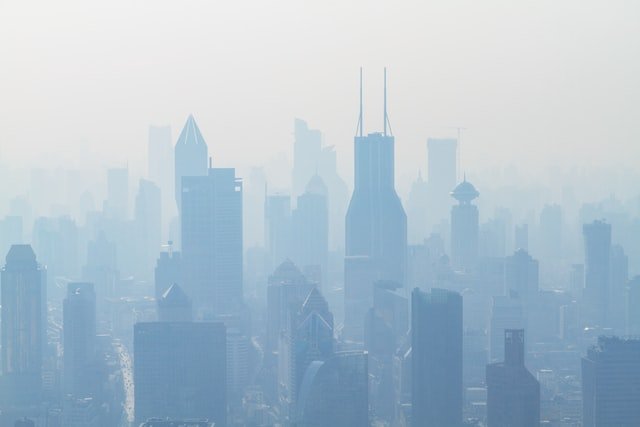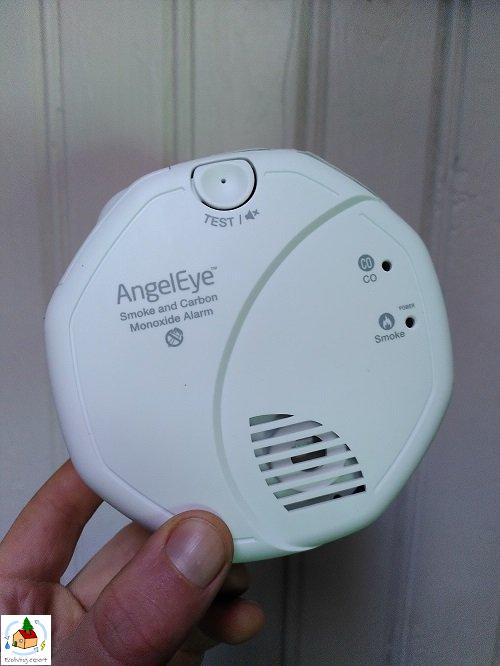You can tell that your indoor air is polluted by identifying the presence of dust, mold, paints, and non-natural cleaning products. Other indicators include filthy ventilation filters, candles, carpets, and nearby traffic and industry. An air quality monitor can measure the exact quality of the air.
The air can be full of potentially harmful compounds. Unfortunately, most air pollutants are very hard to detect. Normally, they are invisible and have no smell. Natural gas is an exception, as it is mixed with a compound that gives it its iconic gas smell. In this way, you can quickly detect it in case of a gas leak.
If you want to know if your air is clean or polluted, you need to look for indicators of poor air as well as nearby sources of air pollution. If any or several of the following are true for your area, you likely have poor air quality.
Indicators of polluted air:
- air pollution related health symptoms
- dust build-up
- clogged ventilation filters
- mold and mildew growth
- bad or strange smell
- poor outdoor air and smog
- the presence of common air pollution sources
Common air pollution sources:
- non-natural cleaning products
- paints and other chemicals
- carpets and rugs
- gas stoves and fireplaces
- geyser, boiler and central heating
- candles and incense
- cigarettes
- nearby traffic
- nearby polluting industry and agriculture
- poor cleaning habits
- Air quality monitor measurements

Looking for in-depth information on what harmful compounds are common in indoor air? My article: The complete indoor air quality guide for your home, lists all the common indoor air pollutants, discusses their health effects, and helps you remove and prevent them.
Measure the air with an air quality monitor
The easiest and most reliable way of checking the air quality in your house is to use an air quality monitor. An air quality monitor is specifically designed to detect many of the potentially harmful compounds that can be present in the air.
If you are looking for a good air quality monitor, I can recommend the Airthings Wave Plus, which not only measures humidity levels and VOCs but also CO2 levels, temperature, air pressure, and radon.
By using this link to the Airthings Wave Plus air quality monitor you will get a 10% discount!
Air-quality related health symptoms indicate poor air
One way of telling whether you have clean or poor air quality is to look for health symptoms related to air quality. Normally health effects due to bad air quality will be minor such as dry eyes, a little fatigue, or a cough. However, some compounds can have more serious health effects.
Increased exposure, whether due to higher concentrations or an extended exposure time, increases the potential health effects. Another important factor is your overall wellbeing, age, and possible sensitivity to the compound.
Health indicators of bad indoor air
Sometimes exposure to air pollutants can lead to immediate health effects. According to the Environmental Protection Agency (EPA), these effects can be (source):
- irritation of the eyes, nose, or throat
- headaches
- dizziness
- fatigue
- increased symptoms of asthma or any other illness

Long-term health effects
The EPA states that long-term health effects of indoor air pollutants may show up years after exposure or after long or repeated periods of exposure. Possible long-term adverse health effects include:
- respiratory disease
- heart disease
- cancer
On top of that, repeated exposure to hazardous substances can cause sensitization.
Dust build-up
Dust particles and especially fine dust (extra small dust particles) are harmful to our lungs. The presence of dust, especially if you need to dust off often, is an indicator that the air is full of particles that can be inhaled.
Fine dust has many causes, including cooking, lighting candles, and outdoor air (coming from car exhausts). Unfortunately, there are no safe levels of fine dust.
Poorly cleaned or maintained ventilation
Ventilation is the most important factor for indoor air quality. Proper ventilation makes sure stale and polluted indoor air is transported outside and fresh outdoor air enters the room.
Is it strongly recommended to make sure you ventilate constantly and sufficiently. Therefore, you need to make sure that your ventilation system is regularly maintained and cleaned. If your ventilation filters are filthy, you can be sure your air quality is not optimal.
A general rule for the ventilation system is to clean it every three months and replace the filters twice a year. This, of course, depends highly on for example if you have pets or allergies (in that case you should replace and clean more often).
Mold and mildew growth
The spores of molds and mildew are always present in the air in very small quantities. They normally do not pose any health hazards. However, when mold spores land in a spot that is humid and warm, they can start to grow and produce very high quantities of spores. This can lead to various health effects and can damage wood and fixtures.
The bathroom is the most common room with mold issues since it is often very wet and the air generally has high relative humidity. Other common areas of mold growth are the basement and unclean kitchens.
For more information on how to check for mold in your home, I recommend reading my article: Do air quality monitors detect mold? (this one can).
Bad or strange smell
Your nose is great at detecting whether food is still edible. But it can also detect gasses and compounds that produce odors. Natural gas is a good example of a gas that can easily be detected by your nose. However, natural gas has an added harmless substance that produces the typical gas smell.
Many air pollutants do not have a scent. However, if you do smell something unpleasant, finding the source and eliminating it will help improve indoor air quality. One air pollutant that can be detected through its scent is formaldehyde. Formaldehyde has a pungent, prickly smell.
Poor outdoor air and smog
Normally, outdoor air is much cleaner than indoor air. In fact, indoor air is generally 3 to 5 times more polluted than outdoor air. However, there are several outdoor sources of air pollution that can sometimes contribute to poor indoor air. These sources are industry, traffic, and agricultural practices. Some days, their pollution output is very large and can enter your home. This is especially noticeable through smell or the presence of smog. Smog is present in certain circumstances when outdoor air, mostly from traffic, is so poor that a darkened mist is formed (smog).

Non-natural cleaning products
Surprisingly, cleaning agents are a source of air pollution. Non-natural cleaning agents often contain compounds that are unhealthy to inhale. These compounds can become airborne when you are using the product, but they can also be released when the bottle is not fully closed. Using multiple different products at the same time is especially discouraged.
It is safest to use natural cleaning agents. Make sure to ventilate properly when cleaning.
Paints and other chemicals
Similar to cleaning products, paints and other chemicals can off-gas and release pollutants into the air. Make sure to store chemicals and paint in a safe place and with a well-closed lid.
Additionally, according to an extensive study on the release of volatile organic compounds (VOCs) during and after painting, it is recommended to at least not use the painted room for 14 days. Another option is to look for low-VOC paint.
Carpets and rugs
The effect of carpets and rugs on air quality is an interesting one. Carpets and rugs trap dust particles when they settle down in stale unmoving. However, they are kicked back into the air when you walk over them. Hereby, they contribute to a continuous circulation of airborne dust.
However, since carpets and rugs trap dust particles, they can be dust sinks when vacuumed regularly. Hereby, they can potentially contribute to the removal of airborne dust.
Additionally, carpets and rugs can themselves be a source of hazardous compounds since they wear out every time you walk on them.
So, the presence of carpets and rugs is an indicator of poor air when you do not clean them often. However, they can help improve indoor air quality when you clean them regularly. In both cases, make sure you have a carpet that is made from natural healthy materials so they don’t release harmful particles when they wear out.
If you are considering purchasing a rug, or already have a carpet or rug and want to replace it, I recommend considering buying a natural rug that does not contain hazardous substances.
Gas stove and fireplace
The gas stove and fireplace are both sources of carbon monoxide as well as fine dust particles. Proper ventilation and airing when using the fireplace or when you are cooking are highly recommended. Installing a carbon monoxide detector is another safety precaution.

Geysers, boilers, and central heating system
Household heating systems are a source of concern mostly due to their emission of carbon monoxide (CO). CO is emitted even from the most efficient appliances. Therefore, it is recommended to hang a few carbon monoxide detectors in your house. Most commonly in the bedroom to protect you while you sleep. Depending on where the water heating system is situated, another CO detector should be installed.
Candles and incense
Candles and incense can, unfortunately, consist of and therefore emit all kinds of potentially harmful compounds. A common air pollutant coming from candles is particulate matter, also called fine dust. These are very small particles that can enter your lungs and damage them. Inhaling these particles is similar to (secondhand) smoking.
Healthier options are vegetable-based candles, soy candles, or beeswax candles. However, no matter what candle you use, u are burning something and therefore releasing tiny soot particles into the air.
Cigarettes
When you smoke cigarettes, air pollutants are the least of your concern. Smoking is far worse than any common air pollutant. However, if anyone in or around your house tends to smoke, this is a clear sign of the presence of air pollutants. Tobacco smoke is a complex mixture of compounds that are toxic and carcinogenic.
Nearby traffic
Traffic is a major source of air pollution. Car exhausts produce several harmful compounds such as nitrogen oxide and soot. On days or hours with heavy nearby traffic, it is likely that the outdoor air is worse than your indoor air. You need to keep ventilation to a minimum and preferably use an air purifier. Make sure to start ventilating again when the outdoor air is relatively clean.
The overall cleanest air is found between 4:00 and 6:00, 12:00 and 16:00, and between 22:00 and 1:00.
Additionally, traffic exhaust chemicals can result in smog. This happens when weather conditions are such that air pollutants are not able to be dispersed, such as on days with low wind speeds.

Nearby industry and agriculture
Not only traffic but also industry and agricultural practices produce large amounts of air pollutants. Some are obvious such as large smoking chimneys, or occasional dust clouds coming from agricultural practices. However, many harmful compounds that are released by industry and agriculture are less noticeable.
Cleaning habits
Cleaning habits greatly influence indoor air quality. More thorough and regular cleaning increases the healthiness of your indoor air. Other things you should be considerate of are:
- never mix cleaning agents unless specified by the manufacturer
- make sure to provide enough fresh air when using cleaning agents
- use natural, no-VOC, cleaning agents
Signs of poor air quality are dust build-up, moisture and mold growth, and a musty smell.
If you are interested in cleaning your house naturally, I recommend reading my article: How to naturally purify the air in your house (a critical review + what actually works)
Air quality monitor measurements
The easiest, most reliable, and most accurate way of knowing your indoor air quality is to use an air quality monitor. An air quality monitor is designed to accurately measure a wide range of air pollutants and warn you of their presence. An air quality monitor can even measure pollutants that cannot be removed by air purifiers. Therefore, an air quality monitor is a safe option that gives you in-depth information, rather than blindly cleaning the air of common pollutants with an air purifier.
For example, radon gas is a naturally occurring carcinogenic gas that can enter your home. this cannot be removed with an air purifier and needs to be dealt with by a professional and constant good ventilation. An air quality monitor is an excellent tool for identifying the presence of radon. You can read all about radon in my article: What is radon? (origin, health risk, and preventive measures).
My recommendation for an air quality monitor
If you are interested in buying an air quality monitor, I would recommend choosing a model that measures a wide range of air pollutants. In this way, you never have to worry if you are missing just that one compound that is causing problems.
I found a Norwegian company called Airthings, which produces excellent air quality monitors. They are easy to operate (just wave your hand in front of the device) and send their data to an app on your phone.
Therefore, I recommend the Airthings Wave Plus. This air quality monitor not only measures airborne chemicals such as VOCs but also CO2 levels, temperature, humidity, and radon.
Discount on Airthings air quality monitor
Use this link to the Airthings Wave Plus air quality monitor to get a 10% discount!

